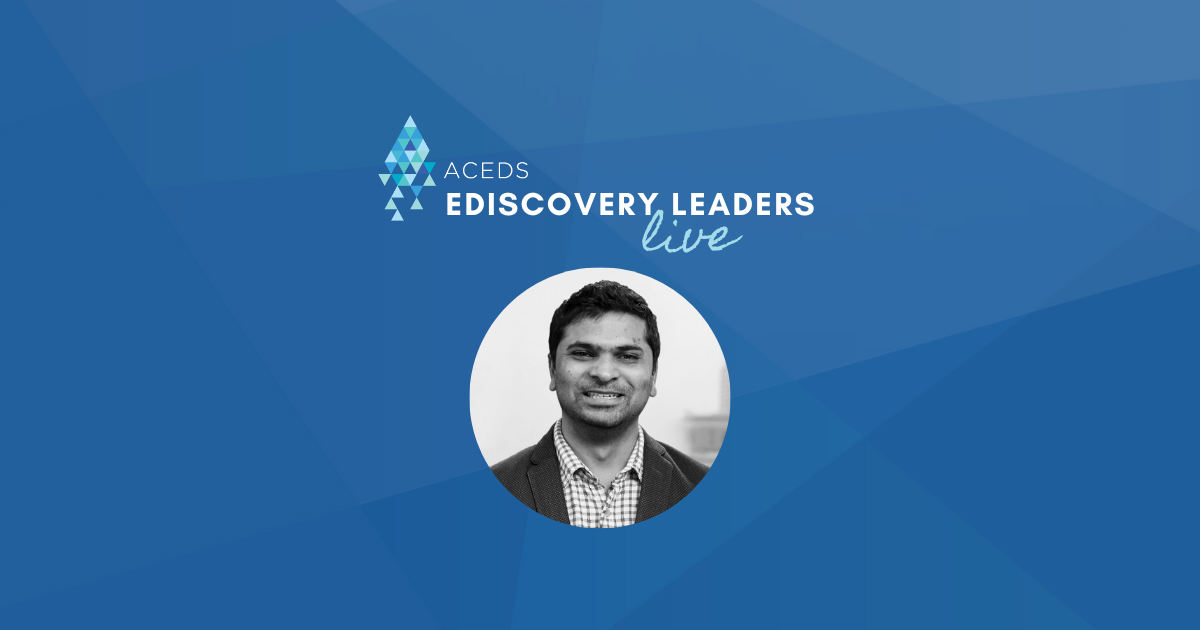eDiscovery Leaders Live: Murali Baddula of Law In Order
Murali Baddula, Chief Digital Officer at Law In Order, joins George Socha, Senior Vice President of Brand Awareness at Reveal, for ACEDS #eDiscoveryLeadersLive.
Murali Baddula is the Chief Digital Officer at Law In Order and has more than 20 years’ experience in litigation support services. He created Law In Order’s Innovation Labs with a group of our internal consulting and development experts. In this role, he collaborates with Law in Order’s inhouse teams and external clients to design and implement workflows and new tools. Prior to becoming Chief Digital Officer, Murali was Vice President of eDiscovery and Head of eDiscovery at Law In Order, assisting legal teams by offering technical solutions and workflows. Before joining Law In Order, Murali worked as Head of Analytics in one of Australia’s leading legal technology firms. Murali holds a Bachelor of Electrical and Electronics Engineering, a Masters in Information Systems, and a Graduate Diploma in Management.
Murali began by sharing the path he took to get to eDiscovery, his path to Law in Order, and his role at the company today. He talked about innovation – the mindset he brings to it and the strategy at Law in Order, how it relates to developing offerings, cultural changes it poses, and the process they follow. He then turned to what Law in Order is doing on the AI front – why they believe in AI, building models including for breach review. He discussed the process they use to build models, the time it takes to build them, and whether they need to be language specific. He then discussed AI model building challenges posed by collaboration content and short messages and issues relating to bias. Murali closed with thoughts on using automation to reduce demands for scarce resources.
Key Highlights
- [2:44] Murali’s role and background.
- [3:31] From data analytics to the eDiscovery space.
- [4:15] Joining Law in Order.
- [5:18} Early days at Law in Order.
- [6:05] About Law in Order.
- [7:45] The mindset he brought to innovation.
- [8:47] Their innovation strategy.
- [9:48] Developing tools and offering solutions to clients.
- [11:22] The culture change challenge posed by innovation.
- [12:33] Capturing ideas and moving them into the innovation process.
- [13:20] Working with clients and their ideas.
- [14:08] The 70/20/10 rule they follow.
- [15:04] The impetus for automation.
- [15:57] Their automation process.
- [16:40] What they are doing on the AI front.
- [17:20] Building models for cyber breach.
- [17:51] Breach review – like eDiscovery but not like it.
- [18:32] In breach review – looking beyond PII.
- [19:19] Building AI models.
- [19:51] Believing in AI.
- [20:20] The process of building AI models and the teams involved.
- [22:26] How long it takes to build a model and why.
- [24:25] Whether models need to be language-specific and why.
- [25:15] AI models and collaboration content.
- [26:03] The challenge of building AI models with chat messages.
- [27:21] Considering bias when building AI models.
- [28:26] Using automation to the reduce demand for scarce resources.
Key Quotes
-
- “People come in with a lot of ideas… For me, it’s understanding them and putting them into the process, and also balancing everyone’s ideas and making sure which ones are attached to our business strategy and getting them into the market.”
- “The good thing with our clients is there are some clients who closely work with us to bring the product to the market.”
- “I believe in AI. More AI, that’s the future. People might be thinking, ‘AI may be taking over a lot of work from us’. I don’t believe in that… We always need people to train AI.”
